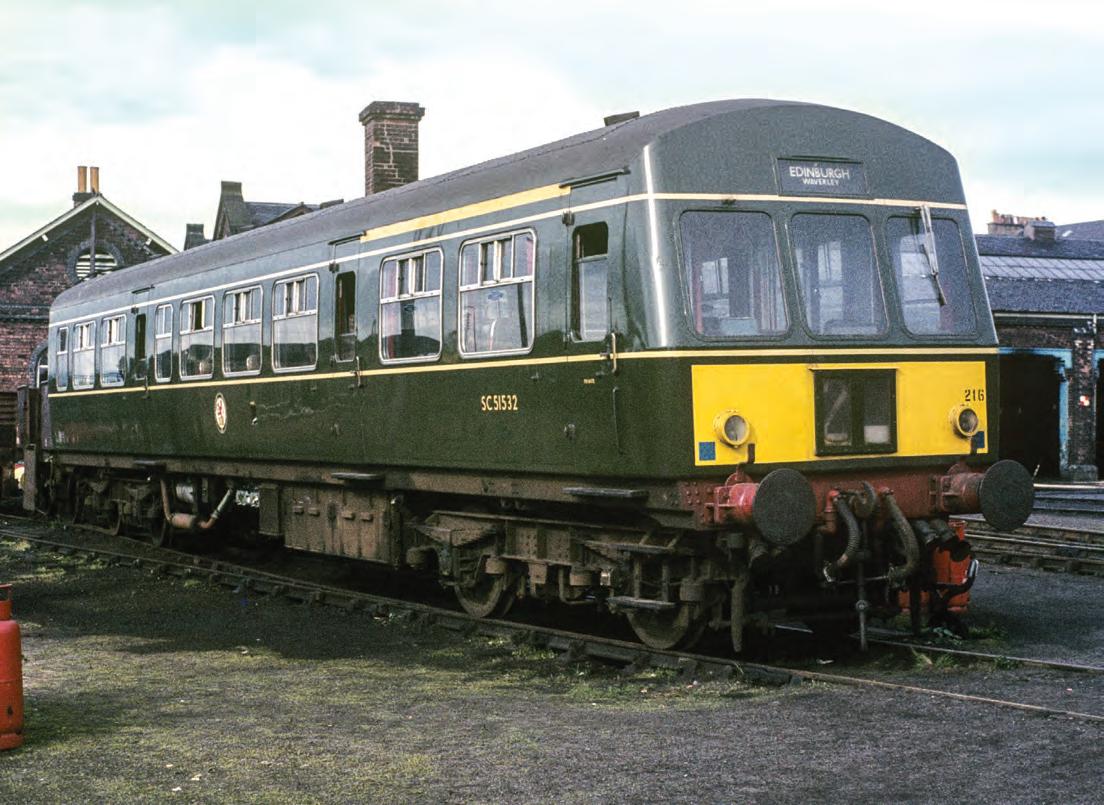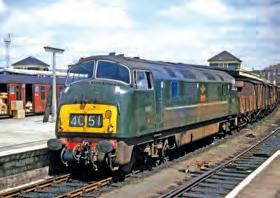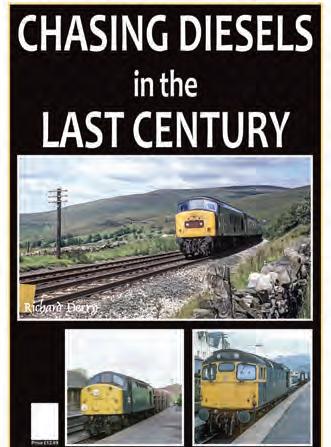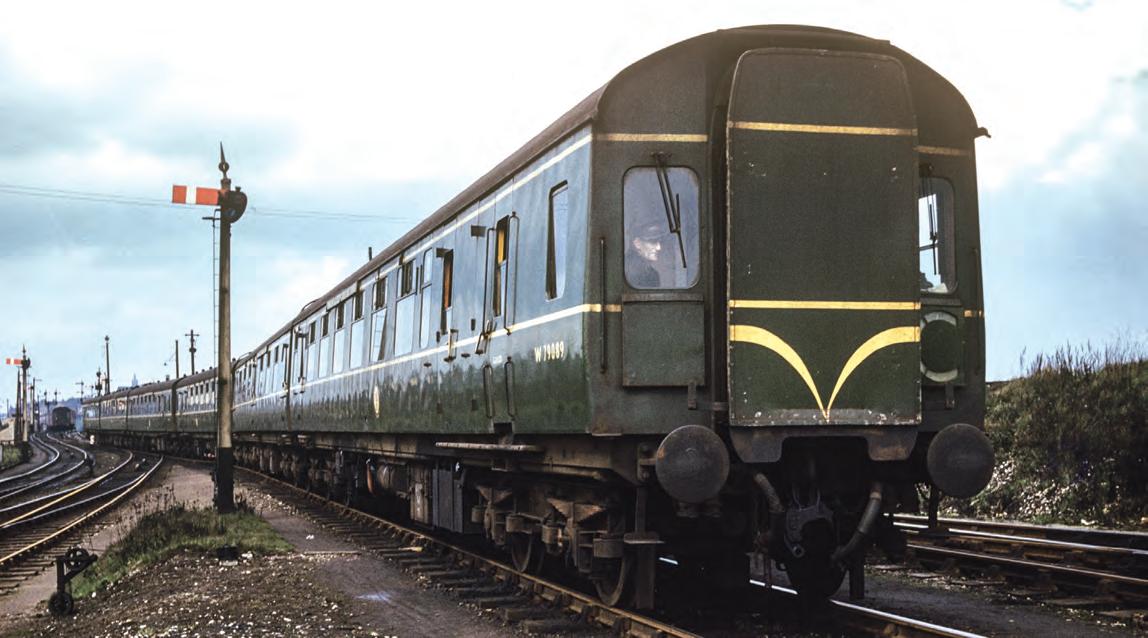DIESEL DAWN
4.DIESEL MULTIPLE UNITS
4.DIESEL MULTIPLE UNITS

A Pictorial Observation
A Pictorial Observation
PP PP Price:
Robert Carroll
£12.99 rice: £12.99 rice: £12.99 rice: £12.99






COMPLETE YOUR DIESEL BUNDLE £35 FOR 4 BOOKAZINES Complete our diesel series with the first, second, third and fifth bookazine. Visit: www.classicmagazines.co.uk/dieselbundle4 Or Call: 01507 529529 Alternatively, these books are available to buy for £12.99 each. Individual copies are also on sale in major UK newsagents, plus other stores. ORDER YOUR BUNDLE TODAY! Using dozens of rare and exclusive photographs – both colour and black and white – the Diesel series covers the origins and operation of British diesel locomotives from their early beginnings in the 1950s to their (sometimes premature) withdrawal from service. SAVE 33% ON THE DIESEL BUNDLE DIESEL DAWN Gavin Glenister and John Jennison Price: £12.99 2. THE SWINDON WARSHIPS D800-D832, D866-D870 2. THE SWINDON WARSHIPS D800-D832, FREE UK DELIVERY
Introduction
A family holiday to Dawlish Warren in August 1972 sparked my interest in diesel multiple units, a type of train I had rarely seen prior to that week in Devon. On a day outing, we travelled in what I later learned was a Gloucester Cross-Country unit (Class 119) to Paignton, changing to another DMU for Kingswear then the ferry across to Dartmouth. The class of that unit forming the Kingswear service bugged me for years afterwards. It was blue, had three cab front windows and a two-character headcode, and was not a suburban unit. Only years later, on seeing a photo in a book, did I establish that it had been a Park Royal unit (Class 103). During that holiday, I also recall seeing Derby suburban units (Class 116). A later holiday to Scotland in 1974 introduced me to many more types of unit. More recent railway modelling activities, and in particular the production of excellent models of several major classes, have reinvigorated my interest in first generation DMUs.
The first generation units themselves were descended from the pioneering work of the Great Western Railway between the wars who, in conjunction with AEC, introduced a fleet of railcars. Although often associated with the 1955 British Railways Modernisation Plan, the first BR DMUs had entered service the previous year. Their rapid construction and deployment was driven by an attempt not only to modernise but to reduce the operating costs of secondary and branch line services. Unfortunately, this was a lost cause in many cases as the lines were closed in the Beeching
era or earlier in some cases. There were even instances of lines being closed before the units being built to work them had entered service.
Outside contractors, as well as BR’s own works at Derby and Swindon, were heavily involved in building DMUs, often being given a degree of freedom in their design and appearance. This led to a proliferation of types, including some that proved unreliable or difficult to maintain.
In addition to branch line and secondary workings, DMUs found themselves employed on intensively-worked suburban routes that were not electrified, such as those from King’s Cross, Paddington and St Pancras in London, around Birmingham and in the South Wales Valleys, as well as on some Inter-City routes such as between Edinburgh and Glasgow and across the Pennines. By the late 1960s, BR found itself with far more DMUs than it needed, and several types were withdrawn when only 10 to 15 years old. A few years later, lack of investment funds and the likely need to retain many first generation units into the 1980s led to a major refurbishment programme for those classes intended to have a long-term future. As the second generation of DMUs entered service from the mid-1980s, many first generation units were withdrawn, priority often being given to those containing blue asbestos insulation, which was by then recognised as a major safety hazard. However, some
Lea
12694
first generation units lasted into the 2000s, long after the second generation of DMUs had entered service.

This account focuses on diesel mechanical and diesel hydraulic types and is intended to give an overview of the types of first generation DMUs and railbuses that could be seen on BR from the 1950s to the 1980s. Most of the images are from my own collection. In addition, Tony Wright has kindly made available many of his own slides. The unit types are presented in BR TOPS (Total Operations Processing System) class order, preceded by those types that were not allocated TOPS classes. The first generation railbuses are also covered although these were not multiple units. For more detail on the history, technical specifications and workings of the various types, the reader is referred to the excellent Railcar Association website at www.railcar.co.uk.
Thanks to Mark Jenkins, Brian Kirby and Tony Wright for their assistance.
Copyright Irwell Press Ltd & Mortons Publishing
ISBN 978-1-911639-66-4 First
3 Diesel Multiple Units
published in the United Kingdom in 2021 by Irwell Press & Mortons Books, Irwell Press, 59A High Street, Clophill, Bedfordshire MK45 4BE Mortons Books, Media Centre, Morton Way, Horncastle LN9 6JR Printed by William Gibbons, UK www.irwellpress.com www.mortons.co.uk/publishing
Progenitors - GWR Railcars 4 Early Derby ‘Lightweight’ DMUs 5 Early Metro-Cammell Units 9 Early Swindon ‘Inter-City’ Units 10 ‘Blue Square’ Low Density Types Gloucester Class 100 11 Metro-Cammell Classes 101 and 102 13 Park Royal Class 103 30 BRCW Class 104 32 Cravens Classes 105 and 106 34 Derby Class 107 41 Derby Class 108 42 Wickham Class 109 53 BRCW Class 110 54 Metro-Cammell Class 111 57 Cravens Classes 112 and 113 58 Derby Class 114 59 ‘Blue Square’ High Density Units Derby Class 115 63 Derby Class 116 65 Pressed Steel Class 117 69 BRCW Class 118 74 Cross-Country Units Gloucester Class 119 78 Swindon Class 120 80 Single Units and Trailers Pressed Steel Class 121 84 Gloucester Class
Later Inter-City
Trans-Pennine Units Swindon Class
Contents
12286
and
12388 Swindon Class 12490
Valley Sets:
Scottish Region Inter-City Sets
Swindon
Pancras-Bedford Sets Derby Class
Parcels Cars97 Four-Wheel Types 100
Derby Class 12592 Later
-
Class
St
12795
The Progenitors - GWR Railcars
The Great Western Railway diesel railcars introduced in the 1930s were the forerunners of the BR first generation DMUs. Ex-GWR Railcar W24W in British Railways crimson and cream livery is at Easton Court on the line between Bewdley and Woofferton. This route, including Easton Court station, closed west of Tenbury Wells in 1961, with the section between Bewdley and Tenbury Wells closing the following year. Between the wars, the GWR took the lead in introducing a fleet of diesel railcars both for lightly-used long-distance cross-country routes and for branch lines. Early railcars were streamlined in appearance and, apart from one, lacked conventional buffers and drawgear. Later cars, including number 24, had a more angular appearance and had buffers and drawgear. Two parcels cars and two 2-car units were also built, some lasting into the early 1960s. [R.Carroll Collection]
An unidentified ex-GWR railcar in BR green livery at Highley on the Severn Valley line in July 1962, shortly before withdrawal. The GWR railcars were powered by a pair of AEC diesel engines coupled to a mechanical transmission. AEC itself had a long history of bus construction, having been the Associated Equipment Company of the London General Omnibus Company. The two were separated when London Transport was formed in 1933. The mechanical arrangements of the GWR railcars formed the basis for many of the DMUs constructed by or for British Railways from 1954 until 1963. [R.Carroll Collection]


4 First Generation
In addition to passenger railcars, the GWR had two that were built for parcels traffic. Number 34, later W34W was to the later, angular body design, with drawgear but number 17, later W17W, was of the earlier streamlined shape and lacked drawgear. The vehicle is in BR crimson livery, around the time of its withdrawal in 1959. [R.Carroll Collection]

Although the mass production of DMUs for British Railways in the 1950s is often associated with the 1955 Modernisation Plan, BR had introduced its first production DMUs the previous year. The first eight 2-car sets built at Derby works on short 57ft frames were powered by a pair of 125hp Leyland engines on each car, coupled to a hydraulic transmission. This arrangement was similar to that used on a prototype diesel unit built by the London Midland & Scottish Railway but was not used on any subsequent units. This meant that the first eight sets were non-standard and were also not capable of working in multiple with any other units, but only within class. Both cars were powered as the units were intended for steeply-graded routes in the West Riding of Yorkshire. Being of lightweight alloy construction, these units became known as ‘Derby Lightweights’. In a black and white image, one of these early twins is near Leeds Central in the mid-1950s. When BR introduced coupling codes to distinguish units with different and incompatible multiple-unit (MU) systems, these units were coded red triangle. Being non-standard, they were all withdrawn in 1964. [R.Carroll Collection]

The Early Derby ‘Lightweight’ DMUs
5 Diesel Multiple Units
After construction of the first eight ‘Derby Lightweight’ units for the West Riding, the engine and transmission arrangements were altered to be more like the ex-GWR railcars, with a pair of 150hp AEC engines coupled to mechanical transmission on the motor coaches. The multiple unit control system also changed, with the revised system being coded yellow diamond. Approximately 200 cars of this type were built. Most were in 2-car sets comprising a driving motor brake third (second from 1956) and a driving trailer composite, which included first class accommodation. A few 2-car sets were built as ‘power-twins’ with engines on both cars. Five 4-car sets and two single units were also built. The unit ends differed from the early ‘red triangle’ variant by incorporating a lower centre marker light and revised MU jumpers. On most units, the cab front windows were divided into two parts by a horizontal bar. This 2-car unit is at Winslow on the Bletchley-Oxford line in 1967. The yellow diamond coupling code markings are visible on the unit end, either side of the yellow warning panel. [R.Carroll Collection]

The later ‘yellow diamond’ Derby Lightweight units were allocated to the Eastern, North Eastern and London Midland Regions. The NER batch included five 4-car sets for working services between Newcastle and Middlesbrough via Sunderland. On the 4-car sets, the guard’s accommodation and van area were included in one of the intermediate trailers. There was a driving motor composite at one end and a driving motor second at the other. This 8-car formation, with the driving motor composite of a 4-car set nearest, is at Waskerley on the RCTS ‘The North Eastern No.2 Rail Tour’ of 10 April 1965. [R.Carroll Collection]

6 First Generation
A few DMU cars gained full yellow ends whilst still in green livery, as on Derby Lightweight driving trailer composite M79607 in the old Hellifield steam MPD yard on 3 June 1967. This car has gained a yellow first class band, which was rare on DMUs in green livery outside the Scottish Region. This car and its adjoining driving motor brake second are from the first ‘yellow diamond’ batch built for West Cumberland lines. The motor brakes of this batch differed from later batches by having a single large bodyside window between the van area and passenger door. Later batches had two small windows and a larger van area. The three cab front windows were each a single pane on this batch. The yellow diamond coupling code has been placed onto a black background to make it stand out against the yellow end. [R.Carroll Collection]

A 2-car ‘Derby Lightweight’ unit comprising driving motor brake second M79177 and driving trailer composite M79467, at Preston on 13 May 1967. The motor brake has been repainted into an early style of BR Corporate ‘Rail Blue’ livery, introduced generally in 1966, with a small yellow warning panel. Full yellow ends became standard from 1967. The unit has bars across the door droplights to prevent passengers from leaning out on account of tight clearances on the Cumbrian Coast lines. North West England became the last stronghold of these yellow diamond units, with final withdrawals taking place in 1969. [R.Carroll Collection]

7 Diesel Multiple Units
Some ‘Derby Lightweight’ units carried Rail Blue livery with full yellow ends, although many were withdrawn still in green livery. This twin unit is in blue livery but still with red buffer beam, at Bicester London Road on a service for Oxford on 30 December 1967; this was the last Saturday of services on the Oxford to Cambridge line, apart from the Bletchley to Bedford stretch, which escaped closure. The Bicester-Oxford section subsequently reopened and this is now the site of Bicester Village station, with through services to Marylebone via a new connection to the former GWR line through Bicester. [R.Carroll Collection]

Two single unit ‘Derby Lightweights’ were built for the Bletchley to Banbury via Buckingham line. One of these units later became test coach ‘Iris’. It is seen at the Crewe open day on 22 September 1979. This vehicle had been M79900. It was later preserved and restored to passenger configuration. A 2-car set from the first West Cumberland batch also survives as does a 2-car battery-powered unit which was built using the same body design as the Derby Lightweights. [R.Carroll Collection]

8 First Generation
The Early Metro-Cammell Units
Metro-Cammell of Birmingham built 36 2-car units with yellow diamond coupling code, numbered in the 79XXX series. Seven sets were allocated to the London Midland Region, principally for services between Bury and Bacup and the remaining 29 went to the Eastern Region, where they worked principally in East Anglia and East London. One of the early Metro-Cammell units is crossing the swing bridge near Somerleyton on the Norwich-Lowestoft line. [R.Carroll Collection]
Two Metro-Cammell DMUs from the original ‘yellow diamond’ series stand at North Woolwich with dockyard cranes visible in abundance in the distance approximately where London City Airport is today. These early Metro-Cammell units were all withdrawn by the end of the 1960s as they were non-standard and surplus to requirements as a result of the many line closures of the 1960s. A few survived long enough to gain blue livery. The line between Stratford and North Woolwich closed in 2006. Much of the formation has since been used for an extension to the Docklands Light Railway and for Crossrail. [R.Carroll Collection]


9 Diesel Multiple Units
The Early Swindon ‘Inter-City’ Units
From 1956, the Western and Scottish Regions introduced Inter-City DMUs. These were built at Swindon Works on long 63ft 5in frames and included driving motor coaches both with and without gangways at the cab ends, often referred to as ‘intermediate’ and ‘leading’ respectively. The leading cars lacked multiple unit jumper cables at the cab ends and could thus be formed only at the ends of sets. Some units included buffet cars. Unlike most DMUs, which had screw couplings throughout, the Inter-City units had Pullman gangways and buck-eye couplings within the set. The Western units worked between Birmingham and Cardiff and the Scottish ones between Edinburgh and Glasgow. The WR units were transferred to join their sisters in Scotland after only a few years service. Here, a three-car WR set is seen at Tyseley depot in Birmingham, with a leading motor brake second nearest. [R.Carroll Collection]

The WR’s Swindon Inter-City units were originally arranged in 3-car sets with a motor brake second at each end, some of which, such as this example, were gangwayed at both ends, with a view to forming 9-car sets, although 6-car and 3-car formations appear to have been more common. The sets built for the Scottish Region had intermediate motor seconds, without guard’s vans, and were usually marshalled in 6-car sets with a trailer first and trailer buffet first in the middle. These units had no marker lights or destination displays. The train classification was denoted by stencils inserted into slots on the driving cabs. Intermediate motor brake second W79089 is leading what appears to be an empty stock working on the Western Region, indicated by the class C headcode. Almost all of these units were taken out of service in 1971, with a few cars surviving to be incorporated into the later Swindon Class 126 fleet, which were the only other units with which they could work in multiple. Several other cars were exported to Liberia and were used on a private railway serving a mine. [R.Carroll Collection]

First Generation
The Scottish Region operated its Inter-City units in three-car formations as well as six. A three-car non-buffet set with a leading motor brake second at the front is at an unknown location between Edinburgh and Glasgow, believed to be on the line via Shotts, in August 1966. The headcode 2 indicates that this was a secondary passenger service. The unit is in the later, darker shade of green, and has gained yellow warning panels. [R.Carroll Collection]

The Gloucester Railway Carriage and Wagon Company (GRCW) built forty 2-car DMUs for the London Midland and Scottish Regions, which became Class 100 under the TOPS (Total Operations Processing System) classification introduced by BR in the late 1960s. One such unit comprising SC56308/SC51109 is at Alloa on a Railway Society of Scotland tour on 12 October 1968. The driving trailer composite carries the early style of Rail Blue livery with small yellow warning panel introduced in 1966. The units had what became the standard ‘blue square’ MU system and the coupling codes are visible on the yellow panel. Alloa had lost its final passenger services shortly before this photo was taken. A new station has since opened on a different site. [R.Carroll Collection]

The ‘Blue Square’ Low Density Types Gloucester Class 100
11 Diesel Multiple Units
A Gloucester/Metro-Cammell hybrid unit stands at Leven in 1969. The Gloucester driving motor brake second carries the early style of full yellow end, wrapping round the cab sides to cover the cab doors. This was abandoned quickly, with the yellow then stopping at the edge of the cab door rather than covering it. The second batch of Gloucester DMUs, which went to the Scottish Region, carried two marker lights on the ends below the cab windows whereas the first batch for the London Midland Region had carried a single light above the destination blind. Leven lost its final passenger services in October 1969 but there are plans to restore services. [R.Carroll Collection]

A Gloucester Class 100 unit at Longniddry on a North Berwick-Edinburgh service on 23 August 1969. The Motor Brake Second leading is from the first batch with a single marker light above the destination blind and retains green livery. The driving trailer has, however, gained blue livery. [R.Carroll Collection]

12 First Generation


























